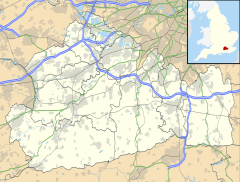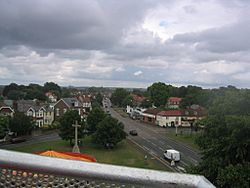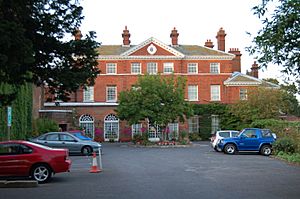Thames Ditton facts for kids
Quick facts for kids Thames Ditton |
|
|---|---|
 St Nicholas's church and riverside terrace and trees from across the Thames |
|
| Area | 1.88 km2 (0.73 sq mi) |
| Population | 9,400 (2021 census) |
| • Density | 5,000/km2 (13,000/sq mi) |
| OS grid reference | TQ155675 |
| Civil parish |
|
| District |
|
| Shire county | |
| Region | |
| Country | England |
| Sovereign state | United Kingdom |
| Post town | THAMES DITTON |
| Postcode district | KT7 |
| Dialling code | 020 |
| Police | Surrey |
| Fire | Surrey |
| Ambulance | South East Coast |
| EU Parliament | South East England |
| UK Parliament |
|
Thames Ditton is a friendly village located on the River Thames in Surrey, England. It's part of the Elmbridge area. This village is about 12 miles southwest of central London. Even though it's just outside Greater London, it's still considered part of the larger London urban area.
Thames Ditton has a charming village centre with shops and cafes along its winding High Street. Around this area, you'll find homes, schools, and sports fields. The riverside part of the village looks out onto the Thames Path and the beautiful Hampton Court Palace Gardens.
The village has its own train station. It's one of two stations on the Hampton Court branch line. This station is about half a mile from the village centre. Thames Ditton is close to other villages like Long Ditton and Weston Green.
Contents
Discovering Thames Ditton's Past
Early History and Growth
The first time Thames Ditton was mentioned in writing was in the year 983. This was in a special paper from King Æthelred the Unready. He gave some land in Thames Ditton to his minister, Æthelmær.
Later, in 1086, the Domesday Book mentioned two places called Ditone and Ditune. The one that is now Thames Ditton was owned by Wadard. At that time, it had a small mill, some fields, and woodland. Only four families lived there.
Over time, different land areas, called manors, became part of Thames Ditton. These included Weston and Imworth. By 1848, Thames Ditton covered about 3,000 acres.
The Church and Local Life
After the Normans arrived, some land was given to monks. They built a small chapel, which is now St. Nicholas Church. The first priest there was recorded in 1179. For a long time, Thames Ditton's church was connected to Kingston. But in 1769, it became its own separate church area.
Thames Ditton was quite isolated because it was surrounded by marshy land. This meant it avoided many problems that bigger towns like Kingston faced.
Hampton Court Palace and Village Life
Thames Ditton became more important after Thomas Wolsey built Hampton Court Palace in the early 1500s. When King Henry VIII took over the palace in 1525, many palace workers and officials moved to Thames Ditton. The village, along with Thames Ditton Island, was a good place to cross the River Thames to get to the palace. This was before the bridge was built in 1752.
King Henry VIII later took over much of the land around the village for hunting. This slowed down development. But after he died, people living there asked for the land to be returned, and normal life started again. Because Thames Ditton was close to London and near famous places like Hampton Court, many people chose to live there.
In the 1700s, there were some problems with crime on the roads. So, in 1792, about 80 local men formed a group to protect people and property. They even made a list of crimes and rewards for catching criminals!
Modern Growth and Changes
In 1801, the population of Thames Ditton was still small, with 1,288 people living in 265 houses. Many worked in farming or trade. There were also many people working in big houses and at Hampton Court Palace.
The village grew a lot in the 1800s, especially after the London and South Western Railway arrived in 1849. This made it much easier to travel to London. The first school was also built around this time. By the early 1900s, Thames Ditton was a popular place for people from London to visit on weekends. It was known for its pretty houses and river activities.
Between the two World Wars, many farming fields were sold to build new homes. This changed the village from a mostly rural area to a more suburban one.
Education in the Past
Around 1812, a school for girls was started in Thames Ditton. Wealthy people helped make this happen. By 1816, at least 60 girls were being taught there. Boys started school in 1818.
In the 1840s, there was a school near St Nicholas' churchyard. In 1860, a new school building was started at the end of Church Walk. Many generations of children from Thames Ditton went to school there.
Local Industries and Innovations
Thames Ditton had a wharf (a place for boats to load and unload) near the Swan Inn. This became a site for local businesses. In 1874, a special bronze foundry opened there called the Thames Ditton Foundry. This foundry made amazing bronze statues that were sent all over the world! Some famous works include the statue known as Eros in Piccadilly Circus and the giant Quadriga at Hyde Park Corner.
Nearby, at Ferry Works, was the factory of Willans & Robinson. In the late 1800s, they made a fast steam engine used to create electricity. Today, this old factory building is still used by different companies.
From 1911 to 1984, the AC Cars factory was in the village. They made cars there. Also, Celestion made its famous "Ditton" loudspeakers in Thames Ditton for many years.
From 1933 to 1994, the Milk Marketing Board had its main office in Thames Ditton. This was a government group that helped with milk production and distribution in the UK.
Famous People from Thames Ditton
Many interesting people have lived in Thames Ditton over the years:
- Lord Henry FitzGerald (1761–1829)
- Charlotte FitzGerald-de Ros, 21st Baroness de Ros (1769–1831)
- Colonel Sidney Godolphin (1652–1732)
- Dudley Carleton, 1st Viscount Dorchester (1573–1632) – lived at Imber Court
- Cesar Picton (1755–1836) – a successful businessman who owned a wharf
- Reverend George Harvest (1728–1789)
- Arthur Onslow (1691–1768)
- George Onslow, 1st Earl of Onslow (1731–1814)
- Edward Sugden, 1st Baron St Leonards (1781–1875)
- Hewett Watson (1804–1881)
- Julian Stafford Corbett (1854–1922) – grew up at Imber Court
- Christian de Duve – a Belgian scientist who won the Nobel Prize in 1974, born in Thames Ditton in 1917.
- Marie Lloyd – a famous entertainer
- Dominic Raab – former Deputy Prime Minister
- Henry Smith – received the Victoria Cross (a very brave award)
- Billy Merson – lived on Thames Ditton Island
- Laurence Naismith – actor, born Thames Ditton 1908
- Dick Emery – comedian
- Charles Heslop – actor, born Thames Ditton 1883
- Sydney Camm – aircraft designer who created the Hawker Hurricane
- Ronan Keating – pop singer
- Haydn Tanner – Welsh rugby player
- Trevor Bannister – actor
- Lucy Alexander – television presenter
- Charlie Brooks – actress
- Douglas Reeman – writer, born in Thames Ditton 1924
- Rob Henderson - British and Irish Lion rugby player
What to See and Do in Thames Ditton
The Thames Ditton railway station connects the village to London Waterloo. This is great for people who travel for work or for students going to Esher College.
The village's High Street is a special area with a mix of homes, offices, and shops. You can find a pharmacy, greengrocer, florist, coffee shops, and several restaurants (Chinese, Indian, Italian, Thai). There are also hairdressers, gift shops, and a post office. Thames Ditton has six pubs, two of which are right by the river! The George and Dragon pub hosts a Farmers' Market every fourth Saturday of the month.
The village has a group called the Residents' Association, which started in 1934. They help look after the local area.
The Vera Fletcher Hall is known as "The Theatre in Thames Ditton." It was built in 1887 as a gift to the community. Famous performers like Petula Clark and the Royal Shakespeare Company have performed there. Local drama and music groups also use the hall regularly.
Important Places to Visit
Boyle Farm (Home of Compassion)
51°23′31″N 0°19′52″W / 51.392°N 0.331°W Boyle Farm is now called the Home of Compassion. It's a large mansion by the River Thames that is now a care home. It was built in 1786. The building used to be surrounded by fields and even owned a small island in the Thames called Boyle Farm Island.
St Nicholas Church
The main church in Thames Ditton, St Nicholas Church, was built a very long time ago. It has beautiful old architecture and is considered a very important historic building.
Giggs Hill Green
This is a triangular village green that covers about 8 acres. It was bought in 1901 to be used for cricket and as a park for people to enjoy. You can find park benches there and it's a nice spot for picnics and informal sports.
Getting Around Thames Ditton
Train Travel
Thames Ditton railway station is on the train line that goes from London Waterloo to Hampton Court. Trains run every half hour. The journey to London Waterloo takes about 33 minutes. You can also connect to faster trains at Surbiton.
Bus Services
Several buses go through Thames Ditton. These include routes 515, 513, 514, 458, and 715. They connect the village to nearby towns like Kingston, Esher, and Weybridge.
Driving by Road
Thames Ditton is close to major roads. It's about five minutes to the A3 road and about 15 minutes to the M3 and M25 motorways. It takes about 35 minutes to get to Heathrow Airport and around 45 minutes to Gatwick Airport, depending on traffic.
Schools in Thames Ditton
- Thames Ditton Infant School
- Thames Ditton Junior School
- St Paul's RC Primary School
For older students, there are nearby schools like Hinchley Wood Secondary School and Sixth Form College and Esher College. There are also private schools in the area.
Flooding in the Village
Thames Ditton has experienced flooding in the past. In 1968, the Ember and Mole rivers overflowed, causing damage to many homes. The floodwaters stayed for several days.
In 2006, a large water pipe burst near the railway station, causing flooding in two streets, the Infants' School grounds, and the High Street.
Sports and Activities
Thames Ditton Cricket Club is the oldest sports club in the village. Cricket has been played on Giggs Hill Green since 1833. The club has many members and a new building. In 2009, the famous West Indies cricket captain Richie Richardson even coached and played for the team!
The Thames Ditton Lawn Tennis Club (TDLTC) is on Weston Green Road. The club has six grass courts and four hard courts. It's a great place for tennis players.
The Thames Ditton Squash Club is located at Colets' Health and Fitness Club. It's known as one of the strongest squash clubs in England, winning many national and European championships.
In Weston Green, you'll find the Old Cranleighan Rugby Football Club and the Old Cranleighan Hockey Club. They have excellent facilities for rugby and hockey.
Metropolitan Police F.C., a football team, is also based in Thames Ditton.
The Thames Ditton Regatta is a rowing event that happens in May. It finishes near Hampton Court Palace.
You can also enjoy traditional river sports like skiffing and punting at the Dittons Skiff and Punting Club. This club was formed in 1923 and hosts its own annual regatta on the river.
Homes and People in Thames Ditton
Thames Ditton is home to about 9,400 people (as of 2021). The area has a mix of different types of homes.
| Output area | Detached | Semi-detached | Terraced | Flats and apartments | Caravans/temporary/mobile homes | Shared between households |
|---|---|---|---|---|---|---|
| (ward) | 725 | 719 | 349 | 653 | 5 | 0 |
Most homes in the area are either detached houses (standing alone) or semi-detached houses (two homes joined together). There are also many flats and apartments.
| Output area | Population | Households | % Owned outright | % Owned with a loan | Hectares |
|---|---|---|---|---|---|
|
|
|
|
|
|
|
A large number of people in Thames Ditton own their homes, either outright or with a loan.
|







